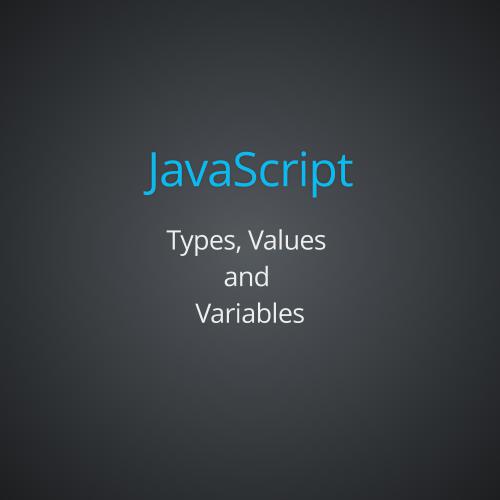Arrays,
Logic and Loops
JavaScript
Having learned about JavaScript's primitive values, now we'll cover the following topics:
- arrays
-
conditional statements
-
loops
Arrays
Arrays
- are ordered lists of values
- are used to store multiple values in a single variable
- there are two ways of creating an array* :
// using a pair of square brackets - the array literal
var myArray = [ 'string', 100, { key: 'value' }, [ 1, 2 ], null, true ];
// using the array constructor function
var myArray = new Array( 'string', 100, { key: 'value' }, [ 1, 2 ], null, true );
- are not primitive values, but a special built-in object
typeof myArray
>> "object"*for simplicity, readability and execution speed, use the first one (the array literal method)
Arrays
creating and adding values
var myArray = [];myArray[5] = "My sixth element";- each item in an array can be treated like a variable, whose values can be changed using the assignment operator
- create an array (the empty array in this case)
- access a specific value using its index (position in the array)
myArray[0]
>> undefined- add values to the array*
myArray[0] = "First array element";
myArray[5] = "Am I the second array element?";*adding elements with high indexes can create undefined "holes" in an array !
! array indexes start with 0
myArray
>> [ "My first element", undefined, undefined, undefined, undefined, "Am I
the second array element?" ];Arrays
removing values
var myArray = [ 0, 1, 2, 3, 4 ];
delete myArray[3];
// now myArray will be [ 0, 1, 2, undefined, 4 ]- removing an item from an array can be done by using the delete operator
the value that was in position 3 has been deleted from the array, but the space that it occupied is still there and contains a value of undefined
this means that the array still has the same number of elements and the position can still be referenced as an index
Array
properties and methods
-
the length property helps finding the length of an array
var myArray = [ 0, 1, 2, undefined, 4 ];
myArray.length = 7;
// myArray is [ 0, 1, 2, undefined, 4, undefined, undefined ]
myArray.length = 3;
// myArray is [ 0, 1, 2 ]
the length property is mutable, so it can be manually changed:
- making the array longer fills the extra slots with undefined
- making the array shorter than it already is, completely removes all the extra elements
- pop() method removes the last item
- push() method appends a new value at the end of the array
- shift() method removes first item
- unshift() method appends a new value at the beginning of the array
var myArray = [ 0, 1, 2, 3, 4 ];
myArray.pop();
// 4 is removed, myArray becomes [ 0, 1, 2, 3 ]
myArray.push(5);
// 5 is added, myArray becomes [ 0, 1, 2, 3, 5 ]
myArray.shift();
// 0 is removed, myArray becomes [ 1, 2, 3, 5 ]
myArray.unshift(6);
// 6 is added, myArray becomes [ 6, 1, 2, 3, 5 ]- concat() method can be used to join two or more arrays
var myArray = [ 0, 1, 2 ];
var myConcatArray = myArray.concat([ 3, 4, 5 ]);
// now myConcatArray is [ 0, 1, 2, 3, 4, 5 ]
// and myArray is [ 0, 1, 2 ]note that this does not change the initial array, it simply creates another array combining the two arrays
assignment would need to be used in order to change the old array to this new array
- join() method is used to turn the array into a string that comprises all the items in the array, separated by a provided separator (or comma by default)
var myArray = [ 0, 1, 2 ];
myArray.join();
// "0,1,2"
myArray.join(" & ");
// "0 & 1 & 2"- the slice() method creates a subarray, effectively chopping out a slice of an original array starting at one index and finishing at the next
var myArray = [ 0, 1, 2, 3, 4 ];
myArray.slice(2,4);
// starts at the third item (index of 2) and finishes
// at the fourth (the item with index 4 is not included)
// [2, 3]
myArray;
// [ 0, 1, 2, 3, 4 ]note that this operation is non-destructive so no items are actually removed from the array
- the splice() method removes items from an array and then inserts new items in their place
var myArray = [ 0, 1, 2, 3, 4 ];
my splicedSubarray = myArray.splice(1,3,'a',6);
// splicedSubarray is [1, 2, 3] while myArray is [0, "a", 6, 4]
myArray.splice(3,0,'b')
// by indicating 0 items to be removed, splice can be used to only
// insert values at a specific index
// myArray is [0, "a", 6, "b", 4]
myArray.splice(2,1)
// myArray is [0, "a","b", 4]
- the first number provides the index at which to start the splice
- the second number tells how many items to remove from the array
- every value after this is then inserted into the array at the same place the other items were removed
- notice that the items removed from the array were returned as a subarray
! to be used instead of delete for removing items completely
- reverse() method is used to reverse the order of an array (order of the array is changed permanently)
var myArray = [ 0, 1, 2 ];
myArray.reverse();
// myArray is [ 2, 1, 0 ]
- sort() method is used to sort the order of an array (order of the array is changed permanently)
var myArray = [ "d", "db", "a", 2, 10 ];
myArray.sort();
// myArray is [10, 2, "a", "d", "db"]
alphabetical order is default for String objects and also for Numbers
- indexOf() method is used to find the first occurrence of a value in an array
var myArray = [ 3, 4, 3 ];
myArray.indexOf(3);
// 0
myArray.indexOf(5);
// -1Multidimensional Arrays
multidimensional arrays are arrays of arrays
var multiDimensional = [[0,1],[“one”,“two”,“three”],[],[true,false]];
var coordinates = [[1,3],[4,2]];
coordinates[0][0]; // 1
coordinates[0][1]; // 3
coordinates[1][0]; // 4
coordinates[1][1]; // 2
to access the values in a multidimensional array, we use two indices:
one to refer to the item’s place in the outer array
one to refer to its place in the inner array
Control structures
JavaScript programs are a sequence of statements (commands) which an interpreter executes one after another in the same order they were written
in order to alter the default order of execution JavaScript has a number of control structures:
conditional (if & switch) that make the interpreter execute or skip other statements depending on the value of an expression
loops (while, do ... while, for) that execute other statements repetitively
jumps (break, return, throw) that cause the interpreter to jump to another part of the program
Conditional statements
Conditional statemets
execute or skip other statements depending on the value of a
specified expression
are the decision points of your code, and they are also sometimes known as “branches”


- the if statement
will allow the code inside the block to run only if the condition is true
if (condition) {
code to run if condition is true
}
if the condition is not a Boolean value, it will be converted to a Boolean, depending on whether or not it is truthy or falsy
var truthy = 1,
falsy = 0;
if (truthy) {
console.log(truthy + ' is `truthy` value');
}
if (falsy) {
console.log('This will not be printed, guess why?');
}- the else keyword
is used to add an extra block of code to run if the condition is false
if (condition) {
code to run if condition is true
} else {
code to run if condition isn't true
}var falsy = 0;
if (falsy) {
console.log('This will not be printed, guess why?')
} else {
console.log('Because ' + falsy + ' is a `falsy value`');
}- the ternary operator
is a shorthand way of writing an if ... else statement
has three operands
condition ? (code to run if condition is true) : (code to run if condition isn’t true)var n = 5;
n%2 === 0 ? console.log(“n is even”) : console.log(“n is odd”);
// n is oddthe ternary operator can make your code more succinct, but can also make it difficult to read, so be careful when you use it !
- the switch statement
can be used instead of lots of if ... else statements when checking the same expression for all the branches
switch (expression) { switch (number) {
case valueOne: case 1:
statementForCaseOne console.log('number is 1');
[break;] break;
case valueTwo: case 2:
statementForCaseTwo console.log('number is 2');
[break;] break;
...
case valueN: default:
statementForCaseN console.log('number isn't 1 or 2');
[break;] }
default: // if there's no default the entire
defaultStatement // block of code is skipped
[break;]
}it is important to finish each case block with the break keyword, as this stops “fall through” (more than one of the case blocks being executed).
Loops
looping statements
- are used to execute other statements repetitively
- bend the path of the source code upon itself to repeat portions of code



- the while loop
will repeatedly run a block of code while a certain condition is true
while (condition) {
do something
}if the condition is not a Boolean value, it will be converted to a Boolean, depending on whether or not it is truthy or falsy
var count = 0;
while (count <= 15) {
console.log(count);
count++;
}
//=> it will print numbers from 0 to 15 then it stopsavoid infinite loops, they will crash your program !
- the do ... while loop
will repeatedly run a block of code while a certain condition is true, the difference from the while loop is that the condition comes after the code block
do {
do something
} while (condition);if the condition is not a Boolean value, it will be converted to a Boolean, depending on whether or not it is truthy or falsy
var test = false;
do {
console.log(test);
} while (test);
//=> it will print `false` and then it stops- the for loop
is a construct that is often more convenient than the while statement because it encodes the loop counter variable
for (initialization ; condition ; after) {
do something
}the initialization code is run before the loop starts; it initializes any variables used in the loop
the condition has to be satisfied for the loop to continue
the after code is what to do after each iteration of the loop, and it is typically used to increment a counter of some sort
for (var count = 0; count <= 15; count++)
console.log(count);
//=> it will print numbers from 0 to 15 then it stops- nested loops
place a loop inside another loop
for(var n=1 ; n<13 ; n++){
for(var m=1 ; m<13 ; m++){
console.log(m + ” multiplied by ” + n + ” is ” + n*m);
}
}var myArray = [1, 2, 3, 4];
for(var i = 0, max = myArray.length; i < max; i++){
console.log(myArray[i]);
}
=> it will print 1 2 3 4- looping over arrays
Javascript Arrays, Logic & Loops
By Azaleea Cristina Constantinescu
Javascript Arrays, Logic & Loops
- 584



